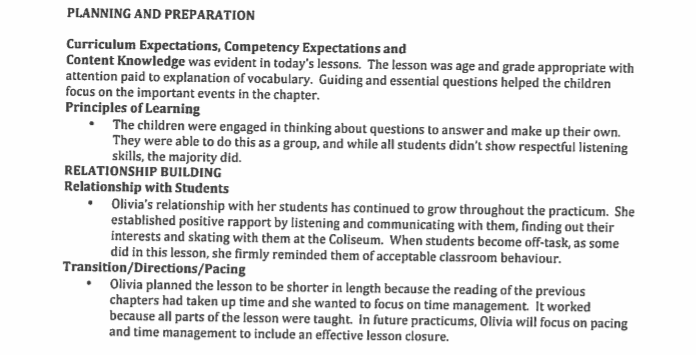Educators implement effective practices in areas of planning, instruction, assessment, evaluation and reporting.
When creating lessons I tend to rely heavily on my training and creative background. I begin by researching the big ideas in the curriculum and expand from this starting point. My planning process contains step by step outlines of lessons that are detailed by time increments. Each lesson plan includes options for differentiation based on the students that I will be teaching, criteria for assessment, and a reflection portion to follow the lesson. Each lesson I created I would consult my coaching teacher as well as fellow cohort members for feedback. I was always trying to improve which would mean a quick reflection at the end of each lesson and then again at the end of the day to refocus myself for the next time. I tried my best to set reasonable goals for each lesson to focus on and then follow with reflection on those goals. I found that this helped me to focus myself and allow me to improve specifics and weaknesses rather than attempting to perfect the entirety of my practice. By scaffolding my learning as an educator I can provide a better quality education for my students.
I believe that assessment should be used as a tool for learning–where are we and where do I as an educator need to go to get my students where they need to be. Assessment should not be a daunting test at the end of a chapter, but rather a celebration and summary of learning.
I learned a significant amount about assessment from my coaching teacher during EDUC-491. I observed my coaching teachers’ practices and tried to make it my own. I began creating a recording system that allowed me to mark off whether students had completed their work or not and if it was submitted on time. Every two weeks I would send home either a homework slip or a congratulations slip. Homework slips would indicate whether homework was handed in late or not at all, which assignments were missing, and what the assignment was focused on in the curriculum. For example, students who were missing a book box item and description during the book box project during the language arts unit, received a slip stating the title of the assignment (Book Box Item + Description), learning standard (reading comprehension), the due date (every Friday), and whether this assignment was still missing or not (yes or no).
I also developed a rubric that would accompany larger projects like the book box assignment. The book box rubric was focused on the ongoing project to recreate the novel students were reading as a book in a box. This project focused heavily on reading comprehension. The literature circles and response sheets were assessed separately from the book box project. Every week, students would recieve a rubric (alternating between book box and literature meeting rubrics) with their progress highlighted as well as included comments. This feedback helped students to understand where they were at within the unit and where they could improve. I also completed verbal assessment that I referenced a single point rubric during literature circles to provide additional ongoing feedback. Students were used to the single point rubric style feedback where we would discuss a portion of the project on a weekly basis during literature circle meetings. Each student would reflect on both achievements and areas of improvement in their project during these verbal assessments. See attached documents below for more details.
In Physical Education, I assessed on the basketball unit we completed. I first had students complete a self assessment in any color except a yellow highlighter by going through a rubric based on the skills learned during gym. I then, explained every activity in the next few days that I was assessing, and how I was assessing it (explaining the quality of each skill I am looking for). I returned all students’ rubrics that I had highlighted using a yellow highlighter. The purpose for the different colors is they combine and change colors when the student and teacher agree on their assessment. The criteria that has been assessed differently than the students’ opinions will be evident by the mismatched boxes.
I plan on refining my assessment practices as I grow as an educator. I am still learning and feel that I was not fully prepared for assessment when it came to my final practicum. My coaching teacher was a fantastic support in this department by showing me some effective strategies but also encouraging me to develop my own. I worked hard with my coaching teacher to adopt and personalize some of their assessment strategies so that I had something that would work for me. I also found it valuable to check in with students and see how they were feeling about the assessment I was implementing. If all of my class was unable to understand my assessment practices then my assessment was completely off base. If I had almost complete or totally complete understanding, my assessment practices and planning was effective.
Attached below is the planning and preparation section of both of my practicum mentor’s formal practicum reports (Practicum 390: February and March 2019).


Attached below is the planning and preparation section of both of my coaching teacher’s formal practicum reports (Practicum 390: February and March 2019).

